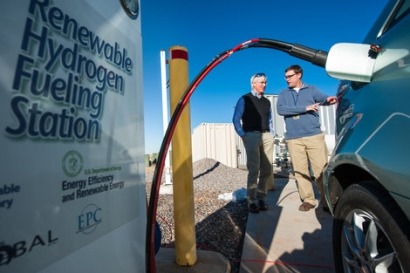
Greater clarity on tax credits and a commitment to rigorous rules on certification are two critical components in the effort to make clean hydrogen a viable and productive force in the US energy mix, a new industry report from US law firm Troutman Pepper has found.
The report, Fueling Up: How to Make US Clean Hydrogen Projects Happen, draws upon the views and expertise of a range of sector specialists to explore what proactive steps must be taken to transform clean hydrogen’s vast potential into a practical reality.
The report argues that - in addition to the above - the US should boost exports to provide additional routes to market, bolster domestic manufacturing for hydrogen technologies, and prioritise ‘backbone’ infrastructure to reduce project risk.
The Inflation Reduction Act and Bipartisan Infrastructure Law have generated considerable commercial interest in American clean hydrogen projects, but the legislation, and implementation of those regulations, come with complexities and caveats that require navigation.
One such issue is tax credits. Designed as incentives to encourage companies to produce clean hydrogen, helping them transition from early-stage development and planning to construction, the arrival of proposed IRS regulations on Section 45V in December 2023 have been considered too stringent by many, offering up more questions than answers.
For hydrogen to be considered ‘clean’ and eligible for credits it must meet three criteria: additionality, time matching, and deliverability. These “3 Pillars” require that hydrogen facilities cannot draw power from a source more than three years older than the hydrogen project, electricity producing hydrogen must be generated within the same hour as the hydrogen, and the electricity source and hydrogen facility must be in the same geographical area, as defined by the DOE’s transmission needs analysis.
Concerned by the perceived strictness of the regulations, many developers and utilities are halting progress, warning that it will drive up costs and make it harder to get projects funded and constructed in this nascent sector, as they cautiously await further clarity from the IRS on its finalised rules.
Meanwhile, off-takers are asking for improved clean hydrogen certification standards to offer transparent reassurance that they are getting the product they think they are. To stimulate demand, the Biden Administration made $7 billion available to support seven regional clean hydrogen production hubs across the country, encouraging users to transition from gray to clean energy sources.
However, businesses inclined to follow this route, such as chemical and metal producers, oil refineries, and transportation and utility companies, are feeling uneasy about the potentially ambiguous nature of hydrogen classifications. Faced with directives to reduce their environmental impact, businesses are struggling with a lack of visibility, guidance, and uniform certification to verify how green any available fuel actually is.
The report notes that more states could encourage greater uptake of clean hydrogen by taking various actions, similar to what numerous states previously did with regard to renewable portfolio targets. For instance, only California, Oregon, and Washington have introduced low-carbon fuel standards thus far. State-led commitments along these lines would provide clean hydrogen users with greater confidence to support the development of a robust domestic clean hydrogen market.
Beyond the domestic market, some commentators within the report argue there is the opportunity to establish the US as a clean hydrogen exporter, particular to Europe and Asia, including in the form of ammonia. Industries globally are under regulatory pressure to decarbonise. Many countries outside the US face greater challenges in relation to their regional energy transition policies, making US hydrogen a potentially attractive proposition, bringing in capital and off-take certainty from around the world, while developing a spot market for clean hydrogen and related products.
Back on US soil, report commentators have encouraged the building out of US manufacturing facilities for hydrogen technologies, while prioritising nationwide ‘backbone’ infrastructure to reduce project risk. Bloomberg New Energy Finance recently reported that 68 percent of global electrolyser manufacturing is in China. In the short-term, this represents a reassuring level of access to equipment, but in the longer-term the federal government has committed to growing domestic production to counteract that reliance.
Equally, interviewees point out that the government needs to unlock investments to support infrastructure, helping producers store and move their product more efficiently and economically. The DOE recognised this challenge in its June 2023 National Clean Hydrogen Strategy & Roadmap, where it reported that between $2 billion and $3 billion of investment annually is needed in hydrogen infrastructure projects between 2023 and 2030 to enable the US to achieve annual production of 10 million metric tonnes by 2030.
“When compiling this report, we found that most commentators and sector specialists agreed about the vast potential of clean hydrogen to become a highly useful non-fossil component of America’s energy mix” said Mindy McGrath, a regulatory and finance Partner in the energy practice group at Troutman Pepper. “And it’s been encouraging to see government incentives and financial support acknowledging that potential in an effort to drive both production and demand. What is less clear at present is how these mechanisms and stimuli will play out in the real world. Regulators are justifiably concerned about doing things the right way. That said, if the rules surrounding the sector are too onerous or ambiguous it is going to stifle progress. Major energy businesses – developers, producers, utilities, and investors - are rightly wary of this uncertainty. In this report we look at why there needs to be a concerted effort to demystify complex regulatory matters, and why clear guidance is needed to create a cohesive framework of strategies to properly advance the sector.”
For additional information:
Report: Fueling Up: How to Make US Clean Hydrogen Projects Happen

